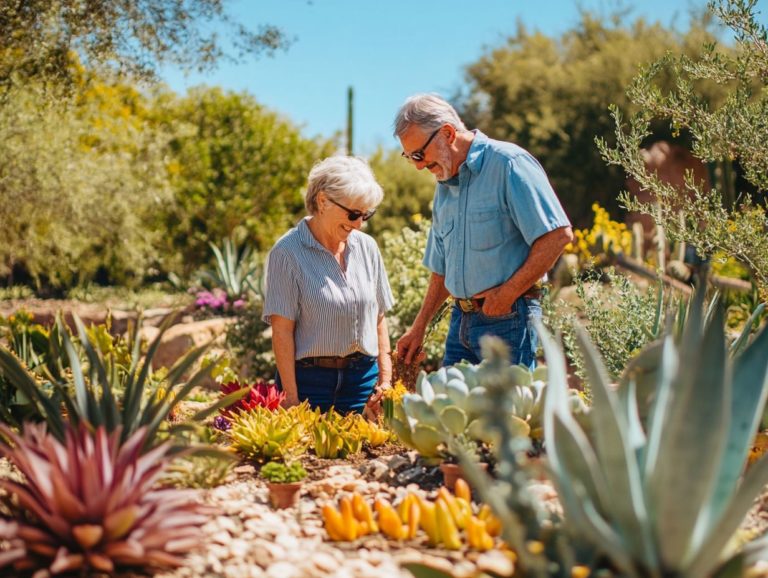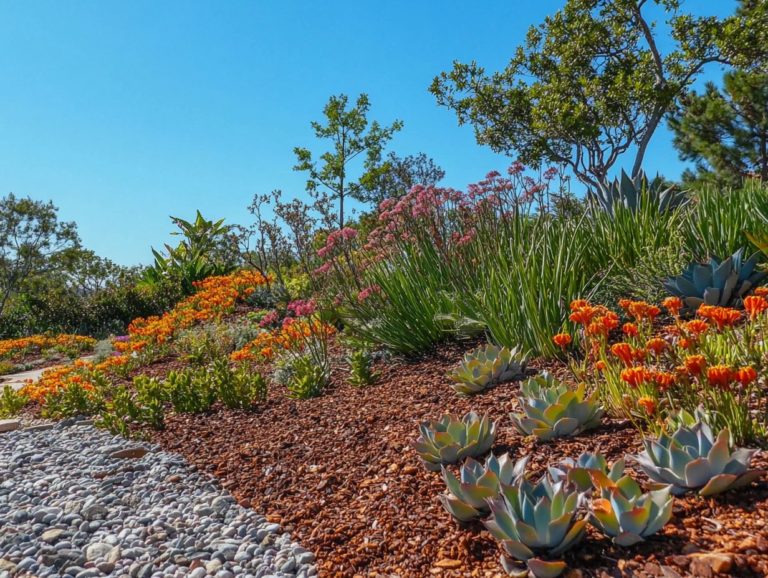The Environmental Impact of Drought-Resistant Gardening
As climate change escalates and water scarcity looms larger, embracing drought-resistant gardening becomes essential for both your personal garden and the overall health of the environment.
Let’s dive into why cultivating drought-resistant plants is not just smart it’s essential for our future! This exploration highlights the importance of growing plants that thrive on minimal water, shedding light on their myriad benefits in water conservation, sustainability, and reducing your carbon footprint.
By employing various gardening techniques, you can achieve a lush garden that conserves resources. You ll find guidance on selecting the right plants, mastering effective watering techniques, and implementing maintenance tips to foster a vibrant drought-resistant garden.
Discover how this approach not only nurtures your green space but also plays a crucial role in combating climate change and supporting local ecosystems.
Contents
- Key Takeaways:
- Why Drought-Resistant Gardening Matters
- Benefits of Drought-Resistant Gardening
- How to Create a Drought-Resistant Garden
- Maintaining a Drought-Resistant Garden
- The Role of Drought-Resistant Gardening in Climate Change Mitigation
- Frequently Asked Questions
- What is the environmental impact of drought-resistant gardening?
- How does drought-resistant gardening help the environment?
- Can drought-resistant gardening contribute to sustainability?
- Does drought-resistant gardening have benefits beyond the environment?
- What are some examples of drought-resistant gardening practices?
- Is drought-resistant gardening suitable for all climates?
Key Takeaways:

- Drought-resistant gardening helps conserve water and reduce our carbon footprint.
- Choosing the right plants and practicing proper watering techniques are key to creating and maintaining a drought-resistant garden.
- Drought-resistant gardening plays a crucial role in mitigating the effects of climate change, both locally and globally.
Why Drought-Resistant Gardening Matters
Drought-resistant gardening is essential in areas like Arizona, including cities such as Phoenix and Scottsdale, where water scarcity presents a formidable challenge to conventional gardening techniques.
By embracing sustainable practices like landscaping that conserves water and choosing native plants you can cultivate a flourishing garden that thrives even in dry climates.
This method conserves precious water resources through various water-saving techniques and enhances ecosystem health and biodiversity, positioning you as a conscientious steward of the environment.
Understanding the Impact of Drought on the Environment
Drought profoundly impacts the environment, influencing everything from soil moisture levels to local ecosystems and biodiversity.
When it doesn t rain for a long time, it disrupts the delicate balance of soil health, leading to compaction and erosion that degrade its fertility. This deterioration adversely affects plant life, stunting growth and reducing crop yields, which can jeopardize food security in vulnerable communities.
As the landscape grows harsher, local fauna struggle to find sustenance and suitable habitats. This results in altered migration patterns and heightened competition for resources. With the added challenges posed by climate change, these environmental shifts underscore the urgent need for sustainable practices.
By embracing initiatives such as water conservation and the restoration of local resources, you can help mitigate the far-reaching effects of drought.
Benefits of Drought-Resistant Gardening
Drought-resistant gardening provides an array of benefits that go well beyond mere water conservation. For instance, exploring the health benefits of gardening with drought plants fosters sustainable practices that are both eco-friendly and highly efficient in their use of water.
Water Conservation and Sustainability
Implementing effective water conservation strategies is crucial for your drought-resistant gardening endeavors. Techniques like drip irrigation and gray water systems emerge as standout eco-friendly solutions.
These methods not only cut down on water waste but also promote healthier plant growth by directing moisture straight to the roots, significantly minimizing evaporation. Enhancing your soil with organic amendments like compost boosts its moisture retention capabilities, ensuring your plants remain adequately hydrated even during dry spells.
Incorporating mulch can help combat surface evaporation, keeping the soil cool and damp. By embracing these water conservation practices, you contribute to environmental sustainability while nurturing resilient landscapes that flourish in challenging conditions, enhancing your garden appeal.
Start your drought-resistant garden today and make a difference!
Reducing Carbon Footprint

Drought-resistant gardening significantly reduces your carbon footprint and showcases your commitment to environmental responsibility by using native and resilient plants. To learn more about this important practice, explore the future of drought-resistant gardening.
By integrating sustainable gardening practices, you can conserve water. This enhances the organic matter in your soil and improves its ability to hold carbon.
This approach supports conservation efforts aimed at preserving diverse plant and animal species. It also fosters a healthy ecosystem.
Using techniques like composting and mulching encourages beneficial microbes. These practices enrich your soil and boost biodiversity!
As local ecosystems thrive, they help regulate temperatures. They also maintain crucial habitats, highlighting the link between your gardening efforts and broader environmental health.
How to Create a Drought-Resistant Garden
Planning your drought-resistant garden is key! Focus on selecting the right plants and choosing effective irrigation methods.
These choices ensure that your garden retains soil moisture and flourishes even in arid conditions.
Choosing the Right Plants
Selecting the right plants is essential for crafting a successful drought-resistant garden. In Arizona, native plants and drought-tolerant landscapes are the best choices for sustainable gardening.
These selections enhance the visual allure of your outdoor spaces. They also play a significant role in boosting local biodiversity and enhancing ecosystem health.
For instance, incorporating species like Fairy Duster, with its vibrant pink flowers, creates a haven for butterflies and bees.
Consider the Palo Verde tree, known for its striking green bark and beautiful yellow blooms. It provides shade and requires minimal water.
By choosing such native treasures, you re not just gardening. You re supporting local wildlife, using indigenous resources, and contributing to resilient ecosystems!
Watering Techniques
Effective watering techniques are crucial for your drought-resistant garden. Consider drip irrigation and gray water utilization for maintaining soil moisture.
These methods promote healthier plant growth and make a significant impact on water conservation efforts.
Automated timers can enhance your watering efficiency. They ensure the right amount of water is delivered at optimal times, reducing waste!
Using soil moisture sensors helps you assess when your plants truly need watering. This minimizes unnecessary irrigation.
With these water-efficient practices, you can cultivate sustainable landscapes that thrive while respecting our precious natural resources. This fosters a harmonious relationship between your gardening efforts and the environment.
Maintaining a Drought-Resistant Garden
To maintain a drought-resistant garden, employ thoughtful care techniques. Regular pruning and weeding promote healthy growth.
Using mulch is essential for retaining moisture and enhancing soil health. This ensures your garden thrives even in arid conditions!
Proper Care and Maintenance

Proper care and maintenance are essential for the longevity of your drought-resistant garden. This means using techniques like adding nutrients to the soil and regular pruning and weeding to maintain plant health.
To cultivate a thriving ecosystem, focus on enhancing soil health by adding organic matter, such as compost or well-rotted manure. This improves moisture retention and provides essential nutrients for your plants.
Mulching around your plants further helps to combat evaporation and keeps weeds at bay. This allows your garden to flourish with minimal water.
Implementing techniques like deep-root watering encourages your plants to develop resilient root systems. This makes them better equipped to withstand dry spells. By embracing these sustainable practices, you create a balanced, healthy environment that supports both plants and animals, nurturing a thriving, drought-resistant habitat.
The Role of Drought-Resistant Gardening in Climate Change Mitigation
Drought-resistant gardening serves as a vital strategy in mitigating climate change. It fosters environmental responsibility and strengthens the resilience of local ecosystems, highlighting the long-term benefits of drought gardening through community resources.
When you embrace these practices, you play a crucial role in preserving our planet’s health and sustainability.
Impact on Local Ecosystems
Drought-resistant gardening enhances local ecosystems, enriching biodiversity and promoting native species. To learn more about this practice, check out the benefits of drought-resistant gardening, which fosters a sustainable environment.
By adopting this approach, you conserve precious water resources and support the intricate web of life within your local habitats.
Choosing plants that thrive in arid conditions provides crucial food and shelter for various pollinators and wildlife, thus playing a vital role in conservation efforts.
These gardens often use local resources, minimizing the need for chemical fertilizers and pesticides. This leads to healthier soil and plants. By using native plants in drought gardening, these practices contribute to sustainable landscaping, promoting ecological balance and climate resilience, especially in Arizona, known for its dry climate.
Global Relevance and Impact
The global importance of drought-resistant gardening is undeniable. As water conservation becomes increasingly vital in the face of climate change, water-saving gardening techniques for drought are more important than ever.
By using native plants and adopting efficient irrigation techniques, you not only conserve water resources but also help your community become more resilient against extreme weather fluctuations.
Empowering yourself and others to implement sustainable gardening methods, including drip irrigation, contributes to wider global conservation efforts aimed at alleviating climate change effects.
These gardening methods help your community take care of the environment, nurturing a sense of stewardship that fosters collective action. Participate in educational workshops on sustainable options to make a difference.
Such practices enhance food security and link ecosystem health to our ability to live sustainably on a global scale, particularly through adding nutrients to the soil and increasing organic matter.
Frequently Asked Questions
What is the environmental impact of drought-resistant gardening?

Drought-resistant gardening has a positive impact on the environment by reducing water usage and conserving resources. For more insights, explore the environmental benefits of drought gardening. It utilizes water-saving techniques and promotes moisture retention.
How does drought-resistant gardening help the environment?
By using plants that require less water, including drought-tolerant landscapes and flowering perennials, drought-resistant gardening minimizes the strain on local water sources. For more insights, explore the long-term benefits of drought gardening. It helps conserve water for other uses.
Can drought-resistant gardening contribute to sustainability?
Yes! Drought-resistant gardening reduces excessive water use. This practice supports sustainable methods like pruning and weeding, as highlighted in the impact of drought on landscaping choices, resulting in a healthier environment.
Does drought-resistant gardening have benefits beyond the environment?
Absolutely! It saves you time and money by requiring less maintenance and lowering your water bills.
What are some examples of drought-resistant gardening practices?
Examples include using drought-tolerant plants and adding mulch to retain moisture. You can also use watering systems that have timers to manage water use efficiently.
Is drought-resistant gardening suitable for all climates?
Yes! While it’s especially beneficial in drought-prone areas like California and Arizona, you can adapt these practices for various climates, still achieving positive environmental impacts.






